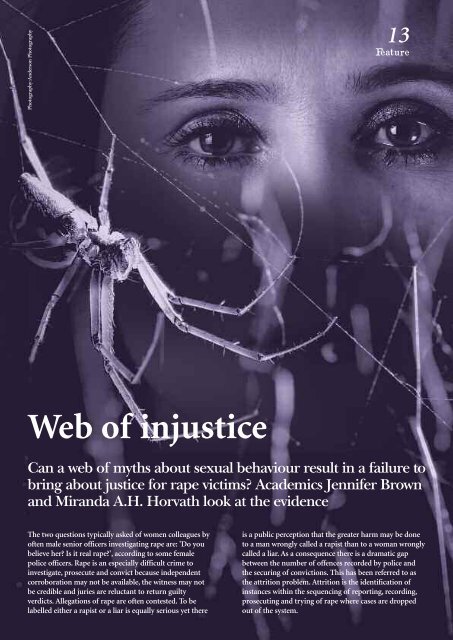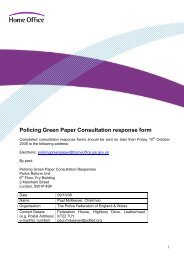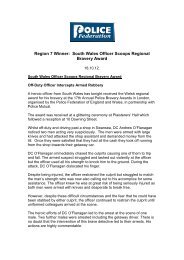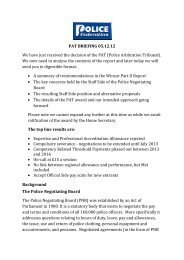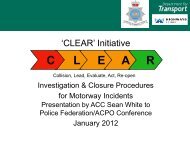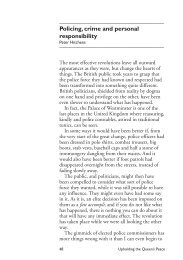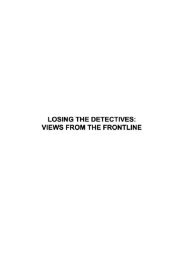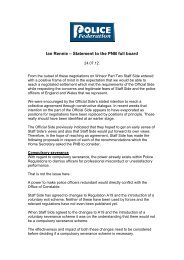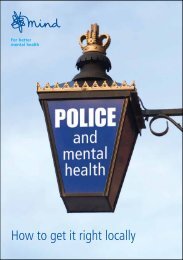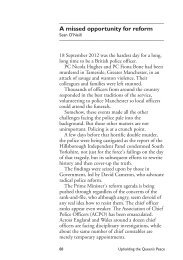Web of injustice - Police Federation of England & Wales
Web of injustice - Police Federation of England & Wales
Web of injustice - Police Federation of England & Wales
You also want an ePaper? Increase the reach of your titles
YUMPU automatically turns print PDFs into web optimized ePapers that Google loves.
Photography:Anderson Photography<br />
<strong>Web</strong> <strong>of</strong> <strong>injustice</strong><br />
The two questions typically asked <strong>of</strong> women colleagues by<br />
<strong>of</strong>ten male senior <strong>of</strong>ficers investigating rape are: 'Do you<br />
believe her? Is it real rape?', according to some female<br />
police <strong>of</strong>ficers. Rape is an especially difficult crime to<br />
investigate, prosecute and convict because independent<br />
corroboration may not be available, the witness may not<br />
be credible and juries are reluctant to return guilty<br />
verdicts. Allegations <strong>of</strong> rape are <strong>of</strong>ten contested. To be<br />
labelled either a rapist or a liar is equally serious yet there<br />
13<br />
Feature<br />
Can a web <strong>of</strong> myths about sexual behaviour result in a failure to<br />
bring about justice for rape victims? Academics Jennifer Brown<br />
and Miranda A.H. Horvath look at the evidence<br />
is a public perception that the greater harm may be done<br />
to a man wrongly called a rapist than to a woman wrongly<br />
called a liar. As a consequence there is a dramatic gap<br />
between the number <strong>of</strong> <strong>of</strong>fences recorded by police and<br />
the securing <strong>of</strong> convictions. This has been referred to as<br />
the attrition problem. Attrition is the identification <strong>of</strong><br />
instances within the sequencing <strong>of</strong> reporting, recording,<br />
prosecuting and trying <strong>of</strong> rape where cases are dropped<br />
out <strong>of</strong> the system.
14<br />
Feature<br />
In order to convey the extent <strong>of</strong> the justice gap, our<br />
research evidence suggests that about 100,000 women are<br />
raped every year in <strong>England</strong> and <strong>Wales</strong>. Figures available<br />
from the British Crime Survey indicate that approximately<br />
12,000 cases are annually reported to the police which<br />
means that perhaps as many as 8 out <strong>of</strong> every 10 rapes go<br />
unreported. Once a rape has been reported, between half<br />
and two thirds <strong>of</strong> cases are dropped by the police and are<br />
either no crimed or no further action is taken. Of the<br />
remaining cases about a third to a half are dropped by the<br />
Crown Prosecution Service and when they do get to court,<br />
about half the cases result in a guilty verdict although this<br />
only represents about six per cent <strong>of</strong> the original number <strong>of</strong><br />
cases coming to police attention.<br />
How may we explain the attrition problem? We argue that<br />
a series <strong>of</strong> rape myths about what constitutes a criminal<br />
case <strong>of</strong> rape are pervasive within society and influence all<br />
those involved, such as the victim, the <strong>of</strong>fender/defendant,<br />
police investigator, prosecutor, and members <strong>of</strong> a jury.<br />
Rape myths are beliefs that operate to deny, downplay or<br />
justify sexual violence that men commit against women.<br />
Typically rape myths blame the victim for their rape; a<br />
woman could resist if she does not want to have sex, express<br />
disbelief in claims <strong>of</strong> rape; women exaggerate assault<br />
behaviour; exonerate perpetrators; what does a woman<br />
expect if she is wearing skimpy clothes, implies only certain<br />
types <strong>of</strong> women get raped; those who get drunk, hang out<br />
in bars. Reliance on these beliefs help people explain and<br />
understand confusing and contested events and rationalise<br />
problematic behaviours. Susan Estrich, an American<br />
academic lawyer, describes “real rape” as a stereotype <strong>of</strong> an<br />
unsuspecting woman forced to have sex without her<br />
consent with a man she does not know and who has a<br />
weapon with which he threatens or uses to overcome her<br />
resistance. Estrich observes that a “real rape” victim reports<br />
her attack directly to the police without washing away any<br />
<strong>of</strong> the forensic traces <strong>of</strong> her attacker. In reality, the presence<br />
<strong>of</strong> all these elements in rape is relatively rare. The research<br />
evidence highlights that women are far more likely to be<br />
assaulted by people they know under social circumstances.<br />
Some recent research carried out by Betsy Stanko and<br />
Emma Williams in the Met <strong>Police</strong> indicated two thirds <strong>of</strong><br />
the rapes took place in the home belonging to either the<br />
suspect or the victim, not in a dark alley; 40 per cent <strong>of</strong> the<br />
victims say an acquaintance raped them and 24 per cent<br />
indicated that the perpetrator was a former intimate partner<br />
not a stranger. Only about ten per cent <strong>of</strong> allegations were<br />
classified as false. So the problem is not the truthfulness <strong>of</strong><br />
the victim rather the difficulty in determining whether the<br />
sex that took place was criminal or not. But judgements<br />
about what took place hinge on what the woman says<br />
rather than the man to figure out whether it was a rape.<br />
Vanessa Munro and Liz Kelly propose in their work,<br />
A vicious cycle, attrition patterns in rape trials,<br />
that a ‘vicious cycle’ operates in which stereotypical thinking<br />
about rape continues to inform decision-making at all<br />
stages <strong>of</strong> the criminal justice process. Rape myths may<br />
inhibit women from reporting rape, because they think they<br />
are not the type <strong>of</strong> woman who gets raped and are unlikely<br />
to be believed. <strong>Police</strong> <strong>of</strong>ficers confirm their beliefs in high<br />
rates <strong>of</strong> false reporting when there is an insufficiency <strong>of</strong><br />
evidence or women withdraw their allegations. Prosecutors<br />
anticipate juror’s response to cases in which the evidence<br />
deviates from the “real rape” scenario and jury’s continue to<br />
acquit because they apply a very high threshold to beyond<br />
reasonable doubt. The vicious cycle creates a self<br />
perpetuating feedback loop in which the prejudicial<br />
disbelief <strong>of</strong> women’s experience is confirmed by the<br />
attrition process within the criminal justice system. It is<br />
women who are considered deviant if the rape is not <strong>of</strong> the<br />
“real rape” type.<br />
The representation <strong>of</strong> rape is in part drawn from media<br />
depictions which feed into myths about rape. Disputed and<br />
contested cases fit into the media agenda <strong>of</strong> exciting and<br />
dramatic stories and there is an increasing coverage <strong>of</strong><br />
stories about false allegations. The emphasis is on the<br />
stranger, serial or multiple perpetrator rape which amplify<br />
the stereotype. Rape is portrayed as exceptional, unusual<br />
and not normalised or routine.<br />
Acceptance <strong>of</strong> rape myths also predicts that a particular<br />
piece <strong>of</strong> information is used prejudicially against the victim<br />
such as her drinking or being drunk. Rape myth acceptance<br />
(RMA) allows people to infer from absent information, for<br />
example if a woman knows the defendant, then high RMA<br />
is associated with the belief that she consented to the sex<br />
rather than it being coerced. <strong>Police</strong> investigators seek either<br />
to test the truthfulness <strong>of</strong> the woman’s account or they<br />
attempt to generate pro<strong>of</strong> that it happened as she said.<br />
Lesley McMillan and Michele Thomas, <strong>Police</strong> Interviews <strong>of</strong><br />
Rape Victims: Tensions and Contradictions, provide some<br />
examples from their police <strong>of</strong>ficer research participants <strong>of</strong><br />
this pro<strong>of</strong> seeking or truth seeking dichotomy: ‘I’m not a lie<br />
detector but what I do...is to get the fine grained detail. Now<br />
the more detail you get the more easy it is to prove whether<br />
they are lying or not’ contrasts with ‘We do our damnedest<br />
to find the evidence if its there’.<br />
So victims are in a double bind. On the one hand they<br />
may be inhibited from reporting a rape if they think that<br />
they are not the type <strong>of</strong> women who might be expected to<br />
be raped. On the other hand if the woman has been<br />
drinking or was raped by someone she knew, this deviates<br />
from the “real rape” stereotype and is likely to be viewed<br />
with disbelief. This situation is further compounded by the<br />
belief that women must be lying because there are so few<br />
convictions. The paucity <strong>of</strong> guilty verdicts also allows men<br />
to rationalise their own aggressive sexual behaviour or<br />
justify the pressures put on women to have sex they do not<br />
want and, as such, men then normalise such sexual<br />
encounters and do not interpret these as rape. How might<br />
we close the justice gap? From a practice perspective, there<br />
clearly needs to be a programme <strong>of</strong> practitioner/academic<br />
engagement to develop practical solutions to challenging<br />
stereotypes and combat rape myth acceptance which could<br />
lead to better training materials and ultimately provide<br />
women with justice at last.


